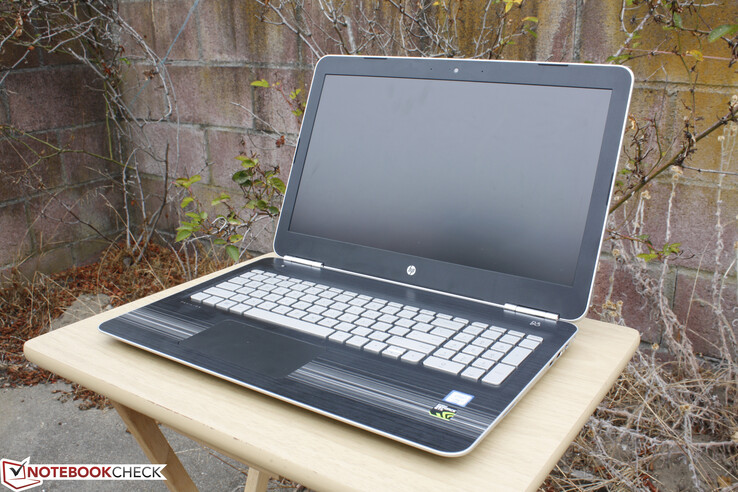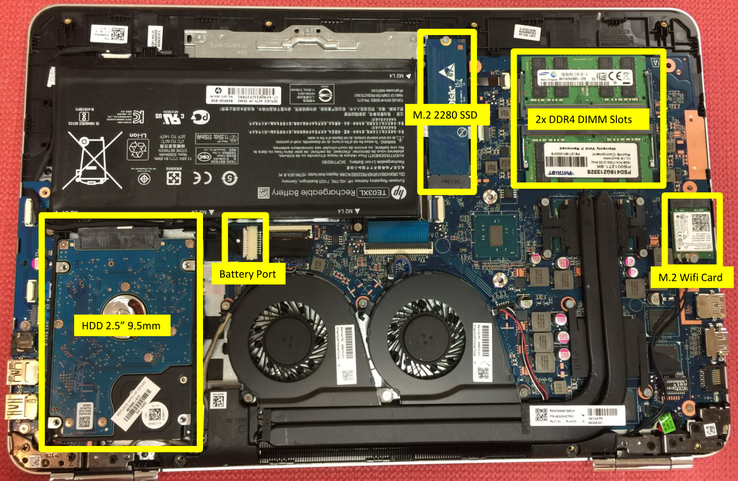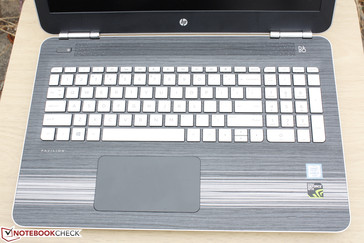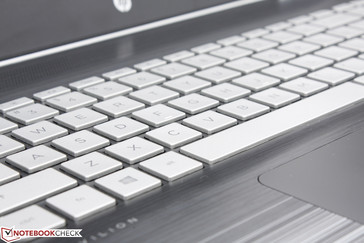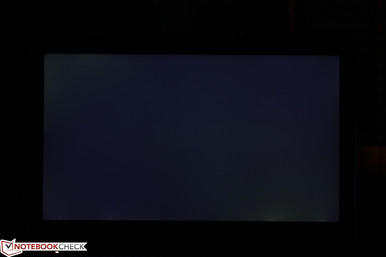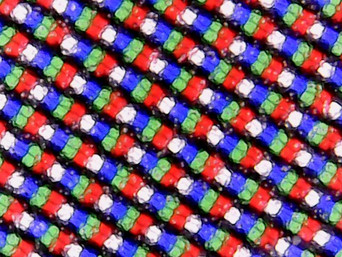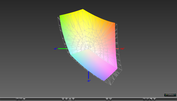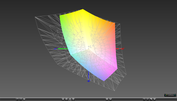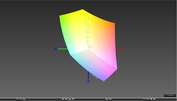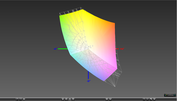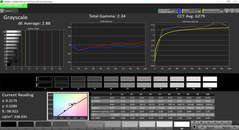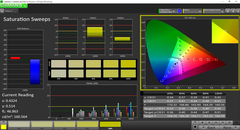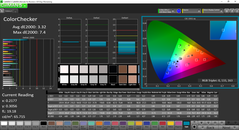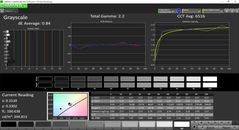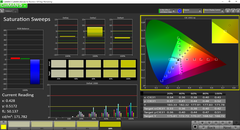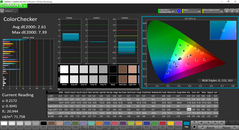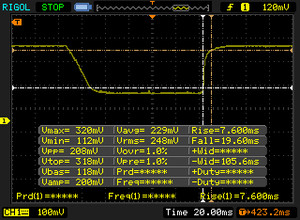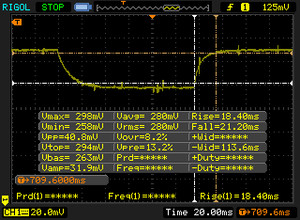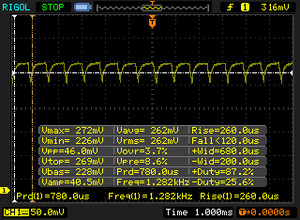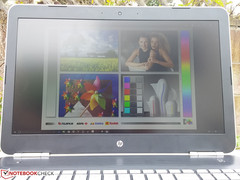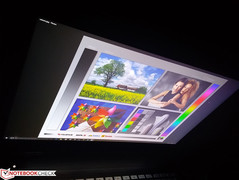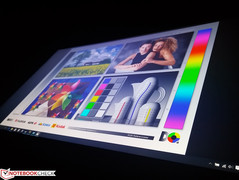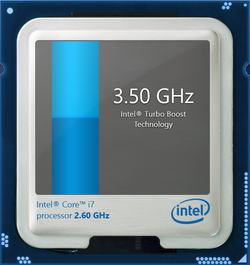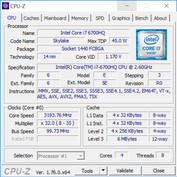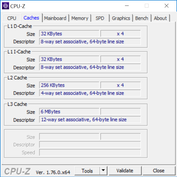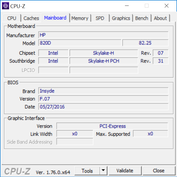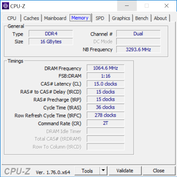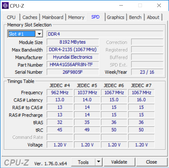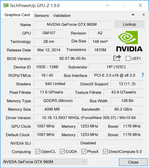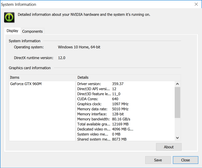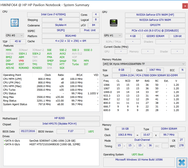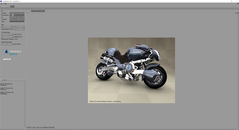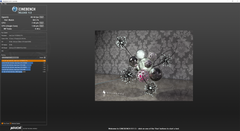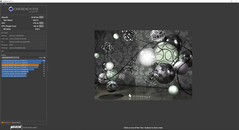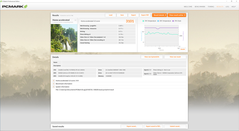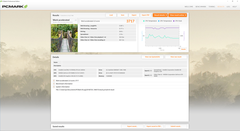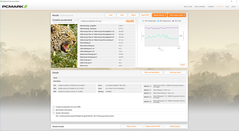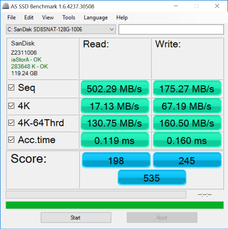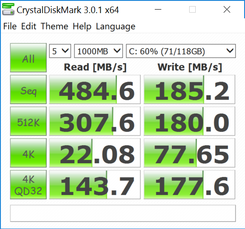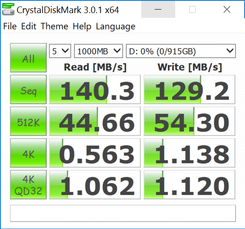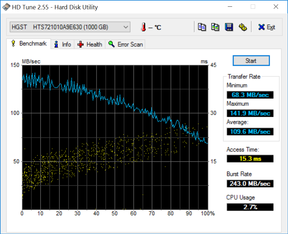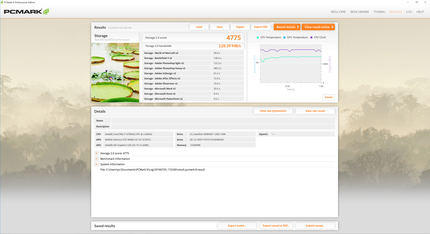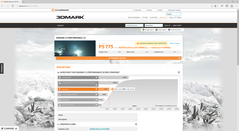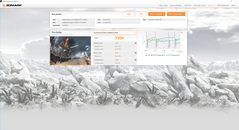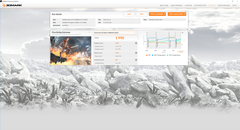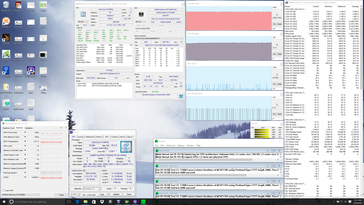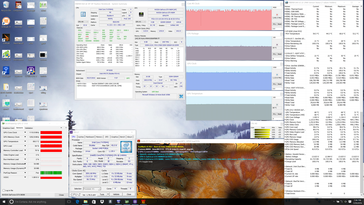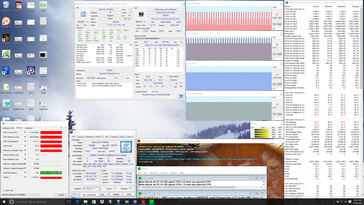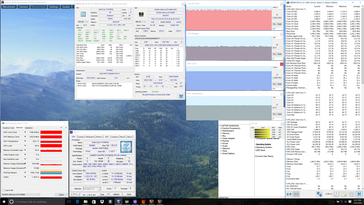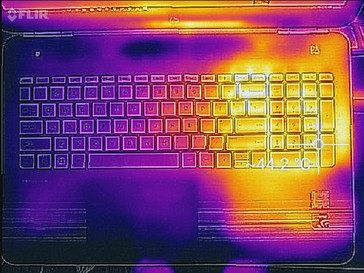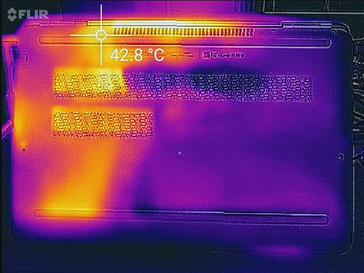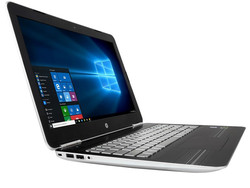HP Pavilion 15 UHD T9Y85AV Notebook Review
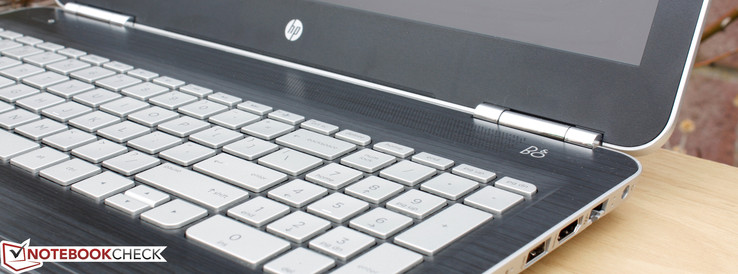
Notebooks like the Dell XPS 15 9550 or Asus ZenBook Pro UX501 show that you don't need a flashy chassis in order to play the latest titles. While the new HP Omen series targets more enthusiast-level gamers, the HP Pavilion series has always been marketed towards the budget-conscious user with GTX 950M options or lower. This latest model adds in a GTX 960M GPU option for a gaming experience matching or exceeding the level of consoles. In fact, it's being sold as a gaming notebook instead of a multimedia solution that the Pavilion series has always been known for.
Our first look will be on the Pavilion 15 with the Pavilion 17 to come in the following weeks. Its design and features have been lifted almost verbatim from the recent HP Omen 15 sans the slightly more powerful GTX 965M GPU, so we recommend checking out our review on the Omen 15 for more information on case quality and input devices since they are essentially identical.
Case
A quick glance at the Pavilion 15 shows it to be a rounded and smooth design with an attractive matte silver finishing not unlike last year's model. Open it up, however, and the notebook exhibits all the examples of an affordable mainstream build. The palm rests, bezel, and base are plastic and pushing down on the center of the keyboard results in moderate warping. The lid in particular could have been more rigid as it warps easily down its center and is susceptible to bending. We weren't fans of the build quality of the Omen 15 and this carries over to the Pavilion 15.
Fortunately, the hinges are of higher quality and an improvement over the previous Pavilion 15 gaming model. They hold the display taut all the way up to its maximum angle with minimal teetering when typing. Otherwise, differences between this and the Omen 15 are mainly skin deep with some texture changes to better distinguish between them.
As for the size and weight, competing models like the ZenBook Pro UX501 is thinner while the MSI GL62 is both larger and heavier. if you're looking for a lighter and more portable 15-inch notebook, however, then the new Dell XPS 15 and its InfinityEdge bezel would be the better (and pricier) option.
Connectivity
Port selection is limited from both a gaming standpoint and a multimedia standpoint. Only the core basics are available including just 3x USB ports (of which two are 3.0) and one video-out option. Competing systems tend to offer multiple video-out options, USB Type-C, or a dedicated microphone port. To HP's credit, however, the system includes a native Gigabit Ethernet port in lieu of a USB Type-C port as found on the XPS 15 and Zenbook Pro UX501. All ports are located closer to the rear of the unit and away from valuable table space.
SD Reader
Performance from the SD card reader is similar to what we find on the MacBook Pro Retina 13 and Pavilion 15 x360 at about 89 MB/s according to AS SSD and our Toshiba Exceria Pro SDXC 64 GB UHS-II test card. The card reader on the newer XPS 13 handily outperforms our HP.
| SD Card Reader | |
| average JPG Copy Test (av. of 3 runs) | |
| Dell XPS 13 2016 9350 (FHD, i7-6560U) | |
| HP Pavilion 15-bk001ng x360 | |
| Apple MacBook Pro Retina 13 inch 2013-10 | |
| HP Pavilion 15 UHD T9Y85AV | |
| maximum AS SSD Seq Read Test (1GB) | |
| Dell XPS 13 2016 9350 (FHD, i7-6560U) | |
| HP Pavilion 15 UHD T9Y85AV | |
| HP Pavilion 15-bk001ng x360 | |
Communication
WLAN is provided by a dual-band Intel 7265 M.2 module capable of theoretical transfer rates of up to 867 Mbps with integrated Bluetooth 4.0. A real-world test when connected to our Linksys EA8500 test router on 802.11ac reveals an average transfer rate of about 493 Mbps.
| Networking | |
| iperf Server (receive) TCP 1 m | |
| Apple MacBook 12 (Early 2016) 1.1 GHz | |
| Asus ZenPad 8.0 Z380M-6B026A | |
| iperf Client (transmit) TCP 1 m | |
| Apple MacBook 12 (Early 2016) 1.1 GHz | |
| Asus ZenPad 8.0 Z380M-6B026A | |
Accessories
There are no included extras outside of the AC adapter and warranty card. Free extras such as mice or cleaning cloths that may be common on higher-end gaming systems are absent in the packaging for the Pavilion 15. HP has only recently begun offering branded gaming accessories for its Omen series of gaming devices.
Maintenance
The bottom panel can be removed with a Philips screwdriver and a sharp edge for prying between the palm rests. HP has told us that the system was not designed to be easily accessible by the end-user and our own attempts show that this is indeed the case.
Fortunately, CUKUSA offers a handy guide for disassembly to reveal core internal features such as the M.2 slots for SSD and WiFi, 2x DDR4 SODIMM slots, and a 2.5-inch SATA bay.
Warranty
Input Devices
Keyboard
The chiclet keyboard is identical to the one on the Omen 15 except that its single-level red backlight is now a standard white. Because the keys themselves are silver in color, the backlight should be deactivated when working under brightly lit conditions or else the keys would actually be more difficult to see. Not exactly a major complaint, but darker keys on most other notebooks have a contrast advantage compared to the Pavilion 15.
Travel and feedback are otherwise satisfactory and nothing special for a multimedia notebook. Keys wiggle very slightly and are not as firm to press as on the chiclet keyboard of an Asus ROG G752. This can be attributed to its more bendable plastic base, so key feedback is softer as a result. Annoyingly, there appears to be no indicator light or onscreen notification for toggling the NumLock key.
Touchpad
The smooth touchpad (12.0 x 6.5 cm) is wide and responsive to both simple cursor control and multi-touch inputs of up to three fingers with the Synaptics software. The main issue is that it operates as a horrible clickpad due to its poor integrated mouse keys. Pushing down to input a click feels very squishy and a higher than average force is required before the input is registered. Furthermore, the feedback itself is weak and soft to make this one of the most uncomfortable clickpads we've experienced on an HP. We find double-tapping on the surface to be much easier should an external mouse be unavailable.
Display
Our test unit carries a 4K UHD matte panel while lower-end SKUs have a 1080p option. While we can't speak for the 1080p panel, the 4K UHD SKU includes a bright backlight at over 300 nits compared to ~250 nits on most 15-inch multimedia notebooks. Look past its resolution and high pixel density, however, and you'll get just an average contrast of about 500:1. Furthermore, a slight graininess to the image is noticeable especially when displaying a bright white background (such as Windows File Explorer). This is common on many matte panels and is one disadvantage compared to notebooks with glossy or glass options. A quick search for its Samsung SDC5958 panel name shows no other notebook in our database with the exact same 4K UHD display.
There is minimal backlight bleeding around the bottom edges and top left corner of our test unit. It's only slightly noticeable during movie playback, but is otherwise unnoticeable when browsing or during day-to-day use.
| |||||||||||||||||||||||||
Brightness Distribution: 87 %
Center on Battery: 336.2 cd/m²
Contrast: 534:1 (Black: 0.629 cd/m²)
ΔE ColorChecker Calman: 3.32 | ∀{0.5-29.43 Ø4.78}
ΔE Greyscale Calman: 2.88 | ∀{0.09-98 Ø5}
85.5% sRGB (Argyll 1.6.3 3D)
55.3% AdobeRGB 1998 (Argyll 1.6.3 3D)
61.8% AdobeRGB 1998 (Argyll 3D)
85.8% sRGB (Argyll 3D)
60% Display P3 (Argyll 3D)
Gamma: 2.34
CCT: 6279 K
| HP Pavilion 15 UHD T9Y85AV SDC5958, IPS, 15.6", 3840x2160 | HP Pavilion 15-ak003ng Samsung SDC5544, IPS, 15.6", 1920x1080 | MSI GL62-6QFi781H11 CMN N156HGE-EAL (CMN15D2), TN LED, 15.6", 1920x1080 | Asus ZenBook Pro UX501VW-DS71T IPS, 15.6", 3840x2160 | HP Omen 15-ax007ng LGD0519, IPS, 15.6", 1920x1080 | |
|---|---|---|---|---|---|
| Display | -27% | 32% | 6% | -16% | |
| Display P3 Coverage (%) | 60 | 43.03 -28% | 85.8 43% | 64.3 7% | 59.9 0% 40.34 -33% |
| sRGB Coverage (%) | 85.8 | 64.7 -25% | 99.8 16% | 89.9 5% | 85.9 0% 60.3 -30% |
| AdobeRGB 1998 Coverage (%) | 61.8 | 44.47 -28% | 84.1 36% | 65.4 6% | 61.6 0% 41.73 -32% |
| Response Times | -12% | 3% | -5% | -27% | |
| Response Time Grey 50% / Grey 80% * (ms) | 39.6 ? | 48 ? -21% | 43 ? -9% | 43.2 ? -9% | 55 ? -39% |
| Response Time Black / White * (ms) | 27.2 ? | 28 ? -3% | 23 ? 15% | 27.2 ? -0% | 31 ? -14% |
| PWM Frequency (Hz) | 1282 ? | 1000 ? | |||
| Screen | 4% | -63% | -22% | -29% | |
| Brightness middle (cd/m²) | 336.2 | 254 -24% | 216 -36% | 252.9 -25% | 214 -36% |
| Brightness (cd/m²) | 323 | 241 -25% | 202 -37% | 250 -23% | 203 -37% |
| Brightness Distribution (%) | 87 | 78 -10% | 83 -5% | 89 2% | 79 -9% |
| Black Level * (cd/m²) | 0.629 | 0.27 57% | 0.48 24% | 0.5 21% | 0.28 55% |
| Contrast (:1) | 534 | 941 76% | 450 -16% | 506 -5% | 764 43% |
| Colorchecker dE 2000 * | 3.32 | 3.54 -7% | 9.98 -201% | 5.22 -57% | 6.04 -82% |
| Colorchecker dE 2000 max. * | 7.4 | 17.12 -131% | 8.33 -13% | 12 -62% | |
| Greyscale dE 2000 * | 2.88 | 2.29 20% | 10.91 -279% | 6.74 -134% | 5.91 -105% |
| Gamma | 2.34 94% | 2.5 88% | 2.31 95% | 2.45 90% | 2.44 90% |
| CCT | 6279 104% | 6698 97% | 13185 49% | 6026 108% | 7362 88% |
| Color Space (Percent of AdobeRGB 1998) (%) | 55.3 | 41 -26% | 75 36% | 58.4 6% | 38 -31% |
| Color Space (Percent of sRGB) (%) | 85.5 | 64 -25% | 100 17% | 89.7 5% | 60 -30% |
| Total Average (Program / Settings) | -12% /
-5% | -9% /
-35% | -7% /
-14% | -24% /
-25% |
* ... smaller is better
Color coverage is approximately 55 percent and 86 percent of the AdobeRGB and sRGB standards, respectively. The gamut is wider than on the outgoing Pavilion 15 and even the new Omen 15 whose panel we found to be just average in terms of color reproduction. Costlier Ultrabooks and gaming models may offer deeper and more accurate colors as an option, but the color space here is more than satisfactory for gaming and office work where precise colors are not required.
Further measurements with an X-Rite spectrophotometer reveal generally accurate colors and grayscale out-of-the-box. Blue and Teal appear to be the least accurate compared to other primary and secondary colors. A quick calibration improves grayscale and colors across the board, but colors still become increasingly inaccurate the higher the saturation level due to the panel's imperfect sRGB coverage.
Display Response Times
| ↔ Response Time Black to White | ||
|---|---|---|
| 27.2 ms ... rise ↗ and fall ↘ combined | ↗ 7.6 ms rise | |
| ↘ 19.6 ms fall | ||
| The screen shows relatively slow response rates in our tests and may be too slow for gamers. In comparison, all tested devices range from 0.1 (minimum) to 240 (maximum) ms. » 68 % of all devices are better. This means that the measured response time is worse than the average of all tested devices (20.2 ms). | ||
| ↔ Response Time 50% Grey to 80% Grey | ||
| 39.6 ms ... rise ↗ and fall ↘ combined | ↗ 18.4 ms rise | |
| ↘ 21.2 ms fall | ||
| The screen shows slow response rates in our tests and will be unsatisfactory for gamers. In comparison, all tested devices range from 0.165 (minimum) to 636 (maximum) ms. » 59 % of all devices are better. This means that the measured response time is worse than the average of all tested devices (31.6 ms). | ||
Screen Flickering / PWM (Pulse-Width Modulation)
| Screen flickering / PWM detected | 1282 Hz | ≤ 59 % brightness setting | |
The display backlight flickers at 1282 Hz (worst case, e.g., utilizing PWM) Flickering detected at a brightness setting of 59 % and below. There should be no flickering or PWM above this brightness setting. The frequency of 1282 Hz is quite high, so most users sensitive to PWM should not notice any flickering. In comparison: 53 % of all tested devices do not use PWM to dim the display. If PWM was detected, an average of 8111 (minimum: 5 - maximum: 343500) Hz was measured. | |||
Outdoor visibility is above average when under shade, but any brighter and colors begin to wash out. An overcast day, for example, will overpower the matte panel and backlight. The wide IPS viewing angles allow for more opportunity to reduce glare without sacrificing image quality unless if viewing from extreme angles. The display itself can be opened up to about 150 degrees.
Performance
The equipped quad-core Core i7-6700HQ is fit for heavy multi-tasking and demanding applications especially when compared to ULV solutions found on most Ultrabooks and some cheaper multimedia solutions. This same CPU can be found on most newer gaming notebooks as well including the Asus ROG G752 and MSI GS60 series. Optimus is supported with the GTX 960M, but it's worth noting that the GPU here is paired with 4 GB of GDDR5 VRAM compared to just 2 GB on the XPS 15 9550 and Zenbook Pro UX501. This gives the HP a very slight advantage in most games and when playing in higher graphical settings.
RAM is provided by two DDR4 SODIMM modules for a total of 16 GB. The system can support up to 32 GB if desired.
Processor
The common i7-6700HQ in our test unit shows no massive performance jumps against the previous generation i7-5700HQ in our MSI PX60. This is expected as the jump from Broadwell to Skylake focuses more on performance-per-Watt rather than a raw increase in CPU power. Stepping up to the desktop Core i7-6700K will net users a 20 to 30 percent performance boost depending on the application.
See our dedicated CPU page on the Core i7-6700HQ for more technical information and benchmark comparisons.
| Cinebench R10 | |
| Rendering Multiple CPUs 32Bit (sort by value) | |
| HP Pavilion 15 UHD T9Y85AV | |
| DogHouse Systems Mobius SS | |
| Asus G701VO-CS74K | |
| MSI PX60 QD-034US | |
| Lenovo IdeaPad Y50 | |
| HP Spectre 13 | |
| Rendering Single 32Bit (sort by value) | |
| HP Pavilion 15 UHD T9Y85AV | |
| DogHouse Systems Mobius SS | |
| Asus G701VO-CS74K | |
| MSI PX60 QD-034US | |
| Lenovo IdeaPad Y50 | |
| HP Spectre 13 | |
| wPrime 2.10 - 1024m (sort by value) | |
| HP Pavilion 15 UHD T9Y85AV | |
| DogHouse Systems Mobius SS | |
| Asus G701VO-CS74K | |
| MSI PX60 QD-034US | |
| Lenovo IdeaPad Y50 | |
| HP Spectre 13 | |
| Super Pi Mod 1.5 XS 32M - 32M (sort by value) | |
| HP Pavilion 15 UHD T9Y85AV | |
| DogHouse Systems Mobius SS | |
| Asus G701VO-CS74K | |
| MSI PX60 QD-034US | |
| Lenovo IdeaPad Y50 | |
| HP Spectre 13 | |
* ... smaller is better
System Performance
PCMark 8 ranks our system in the same ballpark as similarly equipped competitors like the MSI GL62 and Asus UX501. It's PCMark 8 Work score is a little lower than expected, but the system is otherwise subjectively very fast due to its primary SSD. We experienced no abnormal system behavior during our time with our test unit.
| PCMark 8 Home Score Accelerated v2 | 3101 points | |
| PCMark 8 Creative Score Accelerated v2 | 4648 points | |
| PCMark 8 Work Score Accelerated v2 | 3717 points | |
Help | ||
Storage Devices
Both M.2 2280 and 2.5-inch SATA drives are supported up to a thickness of 9.5 mm. NVMe and RAID are not supported unlike on costlier gaming notebooks, so transfer rates are limited by the SATA III standard.
The primary SanDisk SD8SNAT-128G M.2 SSD performs roughly about the same as the ADATA SSD in our Omen 15 if not a little slower. In particular, its sequential write speeds are only average at about 185 MB/s according to CrsytalDiskMark. Meanwhile, the secondary HGST Travelstar 7K1000 HDD returns an average transfer rate of 109 MB/s according to HD Tune, which is very good for a 7200 RPM drive. This secondary storage option is key to gaming on a budget as it allows for an inexpensive mechanical drive.
See our growing table of SSDs and HDDs for more benchmarks and comparisons.
| HP Pavilion 15 UHD T9Y85AV SanDisk Z400s SD8SNAT-128G | HP Pavilion 15-ak003ng Samsung CM871 MZNLF128HCHP | MSI GL62-6QFi781H11 Toshiba HG6 THNSNJ128G8NY | Asus ZenBook Pro UX501VW-DS71T Samsung SM951 MZVPV512HDGL m.2 PCI-e | HP Omen 15-ax007ng Adata IM2S3138E-128GM-B | |
|---|---|---|---|---|---|
| CrystalDiskMark 3.0 | -38% | 51% | 321% | 17% | |
| Read Seq (MB/s) | 484.6 | 465.8 -4% | 530 9% | 1633 237% | 475.7 -2% |
| Write Seq (MB/s) | 185.2 | 120.2 -35% | 442.7 139% | 1579 753% | 169.2 -9% |
| Read 512 (MB/s) | 307.6 | 314.1 2% | 409.1 33% | 1068 247% | 327.6 7% |
| Write 512 (MB/s) | 180 | 75.9 -58% | 417.3 132% | 1570 772% | 169.6 -6% |
| Read 4k (MB/s) | 22.08 | 18.49 -16% | 21.81 -1% | 50.4 128% | 33.14 50% |
| Write 4k (MB/s) | 77.7 | 21.18 -73% | 93 20% | 128.6 66% | 81.4 5% |
| Read 4k QD32 (MB/s) | 143.7 | 94.8 -34% | 257 79% | 534 272% | 276.8 93% |
| Write 4k QD32 (MB/s) | 177.6 | 21.66 -88% | 168.3 -5% | 344 94% | 168 -5% |
GPU Performance
3DMark benchmarks show the GTX 960M in the Pavilion 15 to be over 30 percent faster than the GTX 950M and essentially on par with the larger gaming-centric MSI GL62. The Omen 15 and its GTX 965M is HP's most powerful consumer notebook in terms of graphical prowess as of this writing while higher-end dedicated gaming machines with the GTX 970M can offer an even higher performance boost of about 70 percent over the Pavilion 15.
| 3DMark | |
| 1280x720 Cloud Gate Standard Graphics (sort by value) | |
| HP Pavilion 15 UHD T9Y85AV | |
| Asus Strix GL502VY-DS71 | |
| Asus Strix GL502VT-DS74 | |
| HP Omen 15-ax007ng | |
| MSI GL62-6QFi781H11 | |
| HP Envy 17-n107ng | |
| Dell Inspiron 17 7778 | |
| 1920x1080 Fire Strike Graphics (sort by value) | |
| HP Pavilion 15 UHD T9Y85AV | |
| Asus Strix GL502VY-DS71 | |
| Asus Strix GL502VT-DS74 | |
| HP Omen 15-ax007ng | |
| MSI GL62-6QFi781H11 | |
| HP Envy 17-n107ng | |
| Dell Inspiron 17 7778 | |
| Fire Strike Extreme Graphics (sort by value) | |
| HP Pavilion 15 UHD T9Y85AV | |
| Asus Strix GL502VY-DS71 | |
| Asus Strix GL502VT-DS74 | |
| 3840x2160 Fire Strike Ultra Graphics (sort by value) | |
| HP Pavilion 15 UHD T9Y85AV | |
| Asus Strix GL502VY-DS71 | |
| 3DMark 11 Performance | 5775 points | |
| 3DMark Ice Storm Standard Score | 37758 points | |
| 3DMark Cloud Gate Standard Score | 16612 points | |
| 3DMark Fire Strike Score | 3954 points | |
| 3DMark Fire Strike Extreme Score | 1990 points | |
Help | ||
Gaming Performance
The GTX 960M continues to be a solid GPU for 1080p gaming. However, it's starting to show its age on newer and more demanding titles like Fallout 4 and Rise of the Tomb Raider, so graphical settings will need to be tuned down to Medium-high or High for more stable frame rates of 30 FPS or better. Gaming in native 4K is out of reach for the GPU unless if settings are dramatically reduced.
See our dedicated GPU page on the GTX 960M for more technical information and benchmark comparisons.
| low | med. | high | ultra | 4K | |
|---|---|---|---|---|---|
| Sleeping Dogs (2012) | 91.2 | 24.1 | |||
| BioShock Infinite (2013) | 110 | 45.8 | |||
| Metro: Last Light (2013) | 58.4 | 31.4 | |||
| Thief (2014) | 55 | 28.2 | |||
| Batman: Arkham Knight (2015) | 34 | 22 | |||
| Metal Gear Solid V (2015) | 45.9 | 32.1 | 14.5 | ||
| Fallout 4 (2015) | 29.9 | 24.1 | |||
| Rise of the Tomb Raider (2016) | 29.6 | 23.5 | |||
| Overwatch (2016) | 66.8 | 40.2 | 19.8 |
| Rise of the Tomb Raider - 1920x1080 Very High Preset AA:FX AF:16x | |
| Asus Strix GL502VY-DS71 | |
| Asus Strix GL502VT-DS74 | |
| HP Omen 15-ax007ng | |
| HP Pavilion 15 UHD T9Y85AV | |
| Dell XPS 15 9550 i7 FHD | |
| Medion Erazer P6661 MD 99873 | |
| BioShock Infinite - 1920x1080 Ultra Preset, DX11 (DDOF) | |
| Asus Strix GL502VY-DS71 | |
| Asus Strix GL502VT-DS74 | |
| HP Pavilion 15 UHD T9Y85AV | |
| Dell XPS 15 9550 i7 FHD | |
| Medion Erazer P6661 MD 99873 | |
| Sleeping Dogs - 1920x1080 Extreme Preset AA:Extreme | |
| Asus Strix GL502VY-DS71 | |
| Asus Strix GL502VT-DS74 | |
| HP Pavilion 15 UHD T9Y85AV | |
| Dell XPS 15 9550 i7 FHD | |
| Metro: Last Light - 1920x1080 Very High (DX11) AF:16x | |
| Asus Strix GL502VT-DS74 | |
| HP Pavilion 15 UHD T9Y85AV | |
| Dell XPS 15 9550 i7 FHD | |
| Medion Erazer P6661 MD 99873 | |
| Thief - 1920x1080 Very High Preset AA:FXAA & High SS AF:8x | |
| Asus Strix GL502VY-DS71 | |
| Asus Strix GL502VT-DS74 | |
| HP Pavilion 15 UHD T9Y85AV | |
| Dell XPS 15 9550 i7 FHD | |
| Medion Erazer P6661 MD 99873 | |
| Batman: Arkham Knight - 1920x1080 High / On AA:SM AF:16x | |
| Asus Strix GL502VT-DS74 | |
| Medion Erazer P6661 MD 99873 | |
| HP Pavilion 15 UHD T9Y85AV | |
| Dell XPS 15 9550 i7 FHD | |
| Metal Gear Solid V - 1920x1080 Extra High / On | |
| Asus Strix GL502VT-DS74 | |
| Asus Strix GL502VY-DS71 | |
| Dell XPS 15 9550 i7 FHD | |
| HP Pavilion 15 UHD T9Y85AV | |
| Fallout 4 - 1920x1080 Ultra Preset AA:T AF:16x | |
| Asus Strix GL502VY-DS71 | |
| Asus Strix GL502VT-DS74 | |
| Dell XPS 15 9550 i7 FHD | |
| HP Pavilion 15 UHD T9Y85AV | |
| Overwatch - 1920x1080 Epic (Render Scale 100 %) AA:SM AF:16x | |
| Asus Strix GL502VY-DS71 | |
| HP Omen 15-ax007ng | |
| HP Pavilion 15 UHD T9Y85AV | |
Stress Test
The system performs well when under stressful processing conditions, but maximum stress shows obvious throttling. Running Prime95 results in a stable core clock rate of 3.0 GHz or 100 MHz slower than the rated multi-core maximum for the i7-6700HQ. The issue occurs when running both Prime95 and FurMark simultaneously where CPU clock rates will fluctuate from as low as 450 MHz up to 3.0 GHz. CPU temperature fluctuates wildly as well and the cause for such an atypical behavior can be nailed down to both the high running temperatures of the CPU (up to 93 C) and the limiting 120 W power adapter as shown in our Power Consumption data below. Thus, don't expect to be using the full power of the system when running extreme applications that demand both the CPU and GPU to be running at their respective optimums.
Fortunately, the Pavilion 15 behaves normally under gaming loads as it is able to run Unigine Valley and maintain permanent CPU Turbo Boost and GPU Boost clock rates. Core temperatures remain relatively low as well at around 60 C each.
Running on battery power will reduce both CPU and GPU performances. A 3DMark 11 run on batteries returns Physics and Graphics scores of 6899 and 3265 points, respectively, compared to 8671 and 5452 points when connected to mains.
| CPU Clock (GHz) | GPU Clock (MHz) | Average CPU Temperature (°C) | Average GPU Temperature (°C) | |
| Prime95 Stress | 3.0 | -- | 72 | -- |
| FurMark Stress | -- | 1111 | -- | 68 |
| Prime95 + FurMark Stress | 450 - 3.0 | 1111 | 70 - 93 | 76 |
| Unigine Valley Stress | 3.2+ | 1189 | 58 | 62 |
Emissions
System Noise
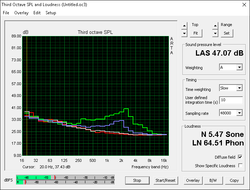
The Pavilion 15 is not a very quiet notebook. Its twin fans are always active no matter the workload and gaming loads will bump fan noise to an even higher 40 dB(A) range. Low-medium workloads like heavy multi-tasking can occasionally bump fan noise up to 35 dB(A). This kind of behavior is common amongst dedicated gaming notebooks, so users making the jump from low-power Ultrabooks to the much more powerful Pavilion 15 will find that the system runs louder overall.
Because of the CPU throttling when subjected to maximum stress as detailed above, maximum fan noise will pulsate between 48 dB(A) and 50 dB(A). This is fortunately not representative of daily workloads, so users should almost never experience fan noise any higher than about 40 dB(A).
Noise level
| Idle |
| 32.3 / 32.4 / 32.4 dB(A) |
| Load |
| 40.5 / 50.3 dB(A) |
 | ||
30 dB silent 40 dB(A) audible 50 dB(A) loud |
||
min: | ||
| HP Pavilion 15 UHD T9Y85AV GeForce GTX 960M, 6700HQ, SanDisk Z400s SD8SNAT-128G | HP Pavilion 15-ak003ng GeForce GTX 950M, 6700HQ, Samsung CM871 MZNLF128HCHP | MSI GL62-6QFi781H11 GeForce GTX 960M, 6700HQ, Toshiba HG6 THNSNJ128G8NY | Asus ZenBook Pro UX501VW-DS71T GeForce GTX 960M, 6700HQ, Samsung SM951 MZVPV512HDGL m.2 PCI-e | HP Omen 15-ax007ng GeForce GTX 965M, 6700HQ, Adata IM2S3138E-128GM-B | |
|---|---|---|---|---|---|
| Noise | -7% | -5% | 8% | -3% | |
| off / environment * (dB) | 29.5 | 30 -2% | 30 -2% | ||
| Idle Minimum * (dB) | 32.3 | 34 -5% | 35 -8% | 28.9 11% | 32 1% |
| Idle Average * (dB) | 32.4 | 35 -8% | 36 -11% | 28.9 11% | 33 -2% |
| Idle Maximum * (dB) | 32.4 | 36 -11% | 37 -14% | 30.2 7% | 36 -11% |
| Load Average * (dB) | 40.5 | 44 -9% | 41 -1% | 41.8 -3% | 43 -6% |
| Load Maximum * (dB) | 50.3 | 51 -1% | 46 9% | 43.9 13% | 49 3% |
* ... smaller is better
Temperature
Surface temperatures when idling and during low loads are generally flat on both sides of the notebook. Any higher, however, and the right half of the system including its palm rest and NumPad will warm up rather quickly compared to the left half. This behavior is unusual and not desirable as most notebooks tend to aggregate temperature development as close to the rear or back corners as possible for more comfortable palms and hands when typing. A glance at how its cooling system is implemented shows us exactly why the temperatures maps below are the way they are. Nonetheless, surface temperatures are a huge improvement over the previous generation Pavilion 15 where hot spots can be as high as 59 C compared to just 42 C on this latest revision. Of course, the throttling behavior of this system under extreme loads means that our test unit could have been even warmer had it performed more consistently.
(±) The maximum temperature on the upper side is 41 °C / 106 F, compared to the average of 40.4 °C / 105 F, ranging from 21.2 to 68.8 °C for the class Gaming.
(±) The bottom heats up to a maximum of 42.6 °C / 109 F, compared to the average of 43.3 °C / 110 F
(+) In idle usage, the average temperature for the upper side is 23.7 °C / 75 F, compared to the device average of 33.9 °C / 93 F.
(±) The palmrests and touchpad can get very hot to the touch with a maximum of 37.2 °C / 99 F.
(-) The average temperature of the palmrest area of similar devices was 28.9 °C / 84 F (-8.3 °C / -15 F).
Speakers
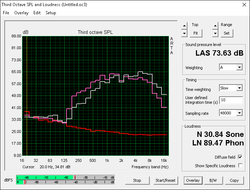
Sound quality from the B&O stereo speakers is nothing remarkable and our same opinions carry over from the Omen 15. The lack of a dedicated subwoofer means poor bass reproduction and an overall tinny experience. Maximum volume is more than sufficient for a small room and the chassis does not reverberate when on high volume settings. External speakers or earphones are recommended for extended multimedia or gaming sessions.
HP Pavilion 15 UHD T9Y85AV audio analysis
(-) | not very loud speakers (64 dB)
Analysis not possible as minimum curve is missing or too high
Apple MacBook 12 (Early 2016) 1.1 GHz audio analysis
(+) | speakers can play relatively loud (83.6 dB)
Bass 100 - 315 Hz
(±) | reduced bass - on average 11.3% lower than median
(±) | linearity of bass is average (14.2% delta to prev. frequency)
Mids 400 - 2000 Hz
(+) | balanced mids - only 2.4% away from median
(+) | mids are linear (5.5% delta to prev. frequency)
Highs 2 - 16 kHz
(+) | balanced highs - only 2% away from median
(+) | highs are linear (4.5% delta to prev. frequency)
Overall 100 - 16.000 Hz
(+) | overall sound is linear (10.2% difference to median)
Compared to same class
» 7% of all tested devices in this class were better, 2% similar, 91% worse
» The best had a delta of 5%, average was 18%, worst was 53%
Compared to all devices tested
» 4% of all tested devices were better, 1% similar, 94% worse
» The best had a delta of 4%, average was 24%, worst was 134%
Schenker F516 Flex audio analysis
(-) | not very loud speakers (69 dB)
Analysis not possible as minimum curve is missing or too high
Frequency Comparison (Checkboxen select/deselectable!)
Graph 1: Pink Noise 100% Vol.; Graph 2: Audio off
Energy Management
Power Consumption
Power draw is about 8 W at its lowest when idling and on minimum brightness. Idling on maximum brightness and on the High Performance profile will essentially double the power demand to 16 W. Gaming will demand just over 70 W of power not unlike on the Asus UX501 or Omen 15. In fact, our readings are very similar to the Omen 15 both when idling and when under heavy loads.
Running both Prime95 and FurMark will draw just under 120 W of power against a power adapter (14.5 x 7.5 x 2.5 cm) rated for 120 W. In other words, the system will use every ounce of power possible from the adapter and we hope to see a larger adapter in the future for more headroom.
| Off / Standby | |
| Idle | |
| Load |
|
Key:
min: | |
| HP Pavilion 15 UHD T9Y85AV 6700HQ, GeForce GTX 960M, SanDisk Z400s SD8SNAT-128G, IPS, 3840x2160, 15.6" | HP Pavilion 15-ak003ng 6700HQ, GeForce GTX 950M, Samsung CM871 MZNLF128HCHP, IPS, 1920x1080, 15.6" | MSI GL62-6QFi781H11 6700HQ, GeForce GTX 960M, Toshiba HG6 THNSNJ128G8NY, TN LED, 1920x1080, 15.6" | Asus Zenbook Pro UX501JW-FI218H 4720HQ, GeForce GTX 960M, SanDisk SD7SN3Q128G1002, IPS, 3840x2160, 15.6" | HP Omen 15-ax007ng 6700HQ, GeForce GTX 965M, Adata IM2S3138E-128GM-B, IPS, 1920x1080, 15.6" | |
|---|---|---|---|---|---|
| Power Consumption | 14% | -8% | -24% | 4% | |
| Idle Minimum * (Watt) | 8.3 | 7 16% | 10 -20% | 15.6 -88% | 7 16% |
| Idle Average * (Watt) | 14.8 | 11 26% | 14 5% | 20.5 -39% | 11 26% |
| Idle Maximum * (Watt) | 16.8 | 17 -1% | 19 -13% | 21.2 -26% | 19 -13% |
| Load Average * (Watt) | 71 | 69 3% | 82 -15% | 75.8 -7% | 79 -11% |
| Load Maximum * (Watt) | 119.2 | 89 25% | 118 1% | 72.9 39% | 119 -0% |
* ... smaller is better
Battery Life
Runtimes are average at just under 4.5 hours of constant WLAN use on a brightness setting of 150 nits (85 percent). Unsurprisingly, the results are again very similar to the recent Omen 15 notebook since they share the same battery capacity. It's worth noting that HP had to upgrade the battery from 48 Wh on the previous generation Pavilion 15 to 61.5 Wh on this latest model to scale alongside the more demanding GPU upgrade. The similarly equipped Asus UX501 can outlast the HP by almost a couple of hours largely due to its much higher capacity internal battery.
Charging from near empty to full will take approximately 1.5 hours.
| HP Pavilion 15 UHD T9Y85AV 6700HQ, GeForce GTX 960M, 61.5 Wh | HP Pavilion 15-ak003ng 6700HQ, GeForce GTX 950M, 48 Wh | MSI GL62-6QFi781H11 6700HQ, GeForce GTX 960M, 41.4 Wh | Asus ZenBook Pro UX501VW-DS71T 6700HQ, GeForce GTX 960M, 96 Wh | HP Omen 15-ax007ng 6700HQ, GeForce GTX 965M, 61.5 Wh | |
|---|---|---|---|---|---|
| Battery runtime | -3% | -33% | 34% | -2% | |
| Reader / Idle (h) | 8.5 | 9.5 12% | 5.7 -33% | 11.5 35% | 7.8 -8% |
| WiFi v1.3 (h) | 4.4 | 5.1 16% | 2.6 -41% | 6.3 43% | 4.5 2% |
| Load (h) | 1.6 | 1 -37% | 1.2 -25% | 2 25% | 1.6 0% |
Pros
Cons
Verdict
The new Pavilion 15 is the intermediate between the GTX 950M-equipped Pavilion 15 of 2015 and the latest GTX 965M-equipped Omen 15 launched just a few weeks ago. Thus, it's also priced accordingly at a few hundred USD less than the entry-level but more graphically capable Omen 15. Since both of these models are essentially identical otherwise, the Pavilion 15 is the more attractive and affordable option for users who want great 1080p gaming performance for $1000 USD or less. It is, essentially, a jack-of-all-trades notebook for work and play.
While not an underperformer in its own right, the latest Pavilion 15 is too marginal of a chassis update over its predecessors and doesn't offer enough to stand out from the crowd. This wouldn't be an issue if it weren't for the likes of the Asus UX501 or Dell XPS 15, both of which are tougher built without sacrificing the high performance GTX 960M GPU. The XPS 15 is noticeably lighter and more portable as well and it becomes difficult to recommend the HP when there are already very strong 15-inch alternatives available. In this case, the biggest advantage of the Pavilion 15 lies in its lower price and it may be worthwhile to skip the UHD configuration for the FHD panel as it pairs more appropriately with the GPU.
A barebones multimedia and gaming system for a cheaper price than the competition. Its hardware and features are underwhelming compared to competitors, but its core gaming capabilities should attract gamers on a budget looking for a one-size-fits-all notebook.
HP Pavilion 15 UHD T9Y85AV
- 08/05/2016 v5.1 (old)
Allen Ngo




